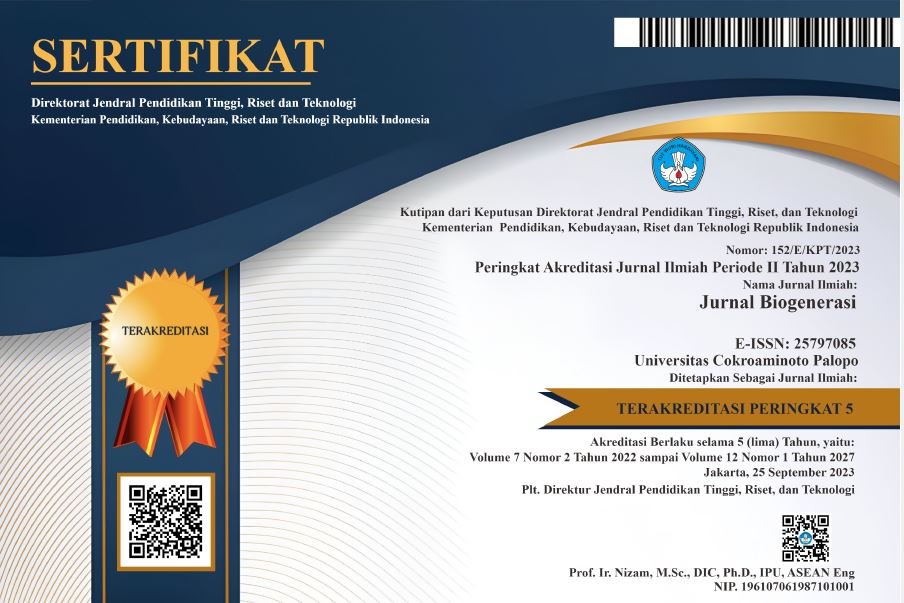Efektivitas Pemberian Pupuk Organik Cair (POC) dari Limbah Kulit Pisang Kepok dan Kulit Mangga Terhadap Pertumbuhan Kangkung Darat (Ipomoea reptans)
DOI:
https://doi.org/10.30605/biogenerasi.v10i2.6291Keywords:
Organic Fertilizer, Plant Growth, Ipomoea reptans, Potassium, Rice Washing WaterAbstract
The excessive application of inorganic fertilizers in agriculture leads to environmental degradation, necessitating sustainable alternatives. This study evaluated the effectiveness of liquid organic fertilizer (LOF) formulated from banana peel, mango peel, and rice washing water on the vegetative growth of Ipomoea reptans. The research employed a Completely Randomized Design (CRD) with four treatment concentrations: 0 ml/L (control), 10 ml/L, 20 ml/L, and 30 ml/L, each replicated three times. Growth parameters assessed at 21 days after planting included plant height, number of leaves, number of roots, and fresh weight. Laboratory analysis revealed nutrient content of 0.04% nitrogen, 0.17% phosphorus, and 3.04% potassium, indicating a potassium-dominant formulation. The 10 ml/L treatment resulted in the highest plant height (18.00 cm), while the 30 ml/L treatment yielded the highest leaf number (9.33) and fresh weight (0.47 g). However, one-way ANOVA showed no statistically significant differences (p > 0.05) among treatments. The novelty of this research lies in utilizing a combination of commonly discarded household organic waste as a low-cost biofertilizer with measurable nutrient content. Although short-term results were statistically insignificant, the formulation demonstrates potential for refinement and longer application in sustainable agriculture
Downloads
References
Faizah, A., Chusniyyah, M. A., Medina, S. I., & Radianto, D. O. (2023). Pengaruh pemberian pupuk organik cair (POC) dari limbah sisa makanan terhadap pertumbuhan tanaman kangkung darat (Ipomoea reptans Poir). Journal of Student Research (JSR), 1(4), 228–235.
Hasma, H., & Winda, W. (2019). Identifikasi senyawa metabolit sekunder ekstrak etanol kulit buah pisang kepok (Musa paradisiaca L) dengan metode KLT. Jurnal Kesehatan Manarang, 5(2), 125–131. https://doi.org/10.33490/jkm.v5i2.176
Ichsan, M. C., Riskiyandika, I. G., & Wijaya, I. (2021). Pengolahan limbah kulit pisang (Musa paradisiaca L.) menjadi pupuk organik cair dan aplikasinya terhadap pertumbuhan tanaman sayuran. Jurnal Agrosamudra, 8(1), 30–39.
Kučuk, N., Primožič, M., Kotnik, P., Knez, Ž., & Leitgeb, M. (2024). Mango peels as an industrial by-product: A sustainable source of compounds with antioxidant, enzymatic, and antimicrobial activity. Foods, 13(4), 553. https://doi.org/10.3390/foods13040553
Latifa, A., & Rachmawati, D. (2020). Pengaruh osmopriming benih terhadap pertumbuhan dan morfofisiologi tanaman kangkung darat (Ipomoea reptans Poir) pada cekaman kekeringan. Jurnal Agronomi Indonesia, 48(3), 245–252. https://doi.org/10.24831/jai.v48i2.31448
Manek, M. P., & Pareira, Y. M. (2025). Pengaruh konsentrasi pupuk organik cair batang pisang terhadap pertumbuhan kangkung secara hidroponik sistem wick. Jurnal Hidroponik Tropis, 2(1), 45–53.
Mardhiana, M., Purnomo, H., Rosmalinda, S., & Sinaga, M. (2020). Pemanfaatan limbah rumah tangga sebagai pupuk organik cair pada tanaman bawang merah (Allium cepa var. ascalonicum (L.) Back). Jurnal Agrifor, 19(2), 337–344.
Purwadi, W. (2017). Pertumbuhan dan Kadar Protein pada Tanaman Kangkung Darat (Ipomea reptans) dengan Pemberian Pupuk Organik Cair (POC) Berbahan Dasar Sabut Kelapa dan Limbah Cair Tahu. Skripsi Universitas Muhammadiyah Surakarta.
Putri, B. G. E., & Hendri, W. (2023). Pengaruh Pemberian POC dari Limbah Sayuran terhadap Pertumbuhan Kangkung Hidroponik. Jurnal Fakultas Keguruan dan Ilmu Pendidikan, 16 (1).
Rahmawati, L., Salfina, S., & Agustina, E. (2020). Pengaruh pupuk organik cair kulit pisang terhadap pertumbuhan selada (Lactuca sativa). In Prosiding Seminar Nasional Biologi, Teknologi dan Kependidikan, 5(1).
Ridwansyah, B, Basoeki, T. R, Timotiwu, P. B, & Agustiansyah, A. (2020). Pengaruh dosis pupuk nitrogen, fosfor, dan kalium terhadap produksi benih padi varietas Mayang pada tiga lokasi di Lampung Utara. Jurnal Agrotropika, 15 (2), 68-72.
Rizal, S., & Medan, D. (2021). Pembuatan pupuk organik cair dari limbah buah-buahan dan sayuran dengan penambahan bioaktivator EM4. Jurnal Agrisains, 12(2), 660–667.
Rohmadi, M., Septiana, N., & Puji Astuti, P. A. (2022). Pembuatan pupuk organik cair dan kompos dari limbah organik rumah tangga. Jurnal Ilmu Lingkungan, 20(4), 880–886. https://doi.org/10.14710/jil.20.4.880-886
Syuryawati, S., & Faesal, F. (2020). Pemanfaatan air cucian beras sebagai pupuk organik pada tanaman jagung. Prosiding Seminar Nasional Pertanian, 1(1), 324–332.
Yenni, F., Handayani, D., & Suryani, I. (2025). Respon pertumbuhan tanaman kangkung (Ipomoea reptans Poir.) terhadap pemberian pupuk organik cair infarm. Jurnal Menara Ilmu, 19(1), 23–32.
Downloads
Published
How to Cite
Issue
Section
License
Copyright (c) 2025 Mega Utami, Alfina Siska Dewi, Galih Hikmal Romadhon, Maura Maharani, Putri Andini, Waliid Naufal, Idramsa Idramsa, Adelia Febriyossa

This work is licensed under a Creative Commons Attribution 4.0 International License.
In submitting the manuscript to the journal, the authors certify that:
- They are authorized by their co-authors to enter into these arrangements.
- The work described has not been formally published before, except in the form of an abstract or as part of a published lecture, review, thesis, or overlay journal.
- That it is not under consideration for publication elsewhere,
- That its publication has been approved by all the author(s) and by the responsible authorities – tacitly or explicitly – of the institutes where the work has been carried out.
- They secure the right to reproduce any material that has already been published or copyrighted elsewhere.
- They agree to the following license and copyright agreement.
License and Copyright Agreement
Authors who publish with this journal agree to the following terms:
- Authors retain copyright and grant the journal right of first publication with the work simultaneously licensed under Creative Commons Attribution License (CC BY 4.0) that allows others to share the work with an acknowledgment of the work's authorship and initial publication in this journal.
- Authors are able to enter into separate, additional contractual arrangements for the non-exclusive distribution of the journal's published version of the work (e.g., post it to an institutional repository or publish it in a book), with an acknowledgment of its initial publication in this journal.
- Authors are permitted and encouraged to post their work online (e.g., in institutional repositories or on their website) prior to and during the submission process, as it can lead to productive exchanges, as well as earlier and greater citation of published work.


.png)

